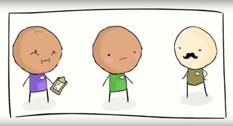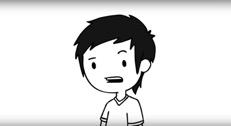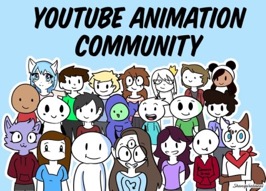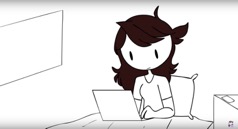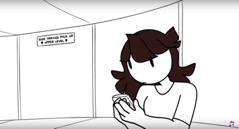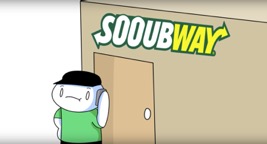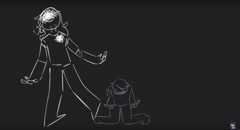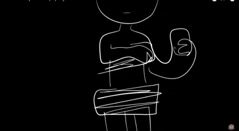The emergence of new media has reshaped the creation and sharing of art in contemporary culture (Catricalà 2015; Krekovic 2003). The arrival of YouTube, in particular, has allowed for “independent modes of producing traditional media genres” (Burgess and Green 2009, n.p) as well as new genres, such as vlogging. An example of a traditional art form that has been independently produced on the online platform, but that has also found ways of integrating such ‘new’ genres, is animation. In 2017, there were more than 30 successful animation-specific channels that created their own content, such as comedy sketches and educational videos, generating more than 11 billion views and 52 million subscribers in total (Akshay 2017). Since then, the rise of a new type of animation, ‘storytime’ animation, has caused a proliferation of animated channels on YouTube. Storytime animation is a form of short animated content specific to the YouTube platform, characterized by autobiographical, usually comedic stories, recognizable personas, a sense of community among animators, as well as simplistic, animatics-style animation. It is now not only the most popular type of animation on YouTube based on view and subscriber count, but also the one most associated with the platform. Despite its popularity and unique cultural place as a distinctive form of animation which has grown in a new media environment, YouTube animation has been entirely neglected by animation scholars. While its non-fictional nature might lead us to compare it to the genre of animated documentaries, the autobiographical perspective, conversational tone, and markedly disparate institutional and cultural positioning of these videos require a different framework than that proposed by Honess Roe’s (2013) book Animated Documentary, as their function does not seem to fall under the categories of mimetic substitution, non-mimetic substitution, or evocation. In this essay, I will both examine how and why storytime animation has become the dominant form of independent online YouTube animation by outlining its history and identifying its main characteristics to demonstrate how YouTube as a new media platform shapes the kind of animation that thrives on the platform.
A History of YouTube Animation: From Newgrounds to Storytime
The history of YouTube animation begins with another site – Newgrounds, a platform founded in 1995 by Thomas Fulp hosting user-generated content with the slogan “Everything, By Everyone” (Newgrounds 2019). In 1999, the site updated its portal to a system that allowed users to upload Adobe Flash content.[1] While other platforms also employed this feature due to the popularity of Flash animations such as WhirlGirl (Amid 1999), this was the only place where, for the first time, users could upload their Flash cartoons for free. This led to a proliferation of web cartoons in the 2000s created by young adults – characteristically amateur and cartoonish short animations, many of which became viral and reached millions of views on the site. On the Newgrounds “portal”, as it was known, “there was no middleman, no networks to appease, no markets to embrace. [It] was a community where kids could relate with each other using their own humour, their own skills, their own passions, their own language” (Winkie 2015, para. 5). Towards the end of the decade, however, as the largely teenaged animators were growing up, they needed a source of revenue, and although Newgrounds itself was earning ad revenue, its creators were not (FootofaFerret 2018). At the same time, another online video-sharing platform, YouTube, was quickly growing. Not only did the videos load faster on YouTube, but they could also be monetized, thanks to the YouTube Partnership Program, which launched in 2008 and offered to pay a selected number of creators for their videos (Cunningham et al. 2016).
Monetization was thus the driving cause for independent online animators’ migration to YouTube. This also led to both an improvement in animation quality and an increase in viewership numbers, making the years 2008-2012 the “golden age of online animation” (FootofaFerret 2018, 4:48). The most popular animated videos at this stage were either video game parodies (eg. HarryPartridge – see Figure 1) or comedy sketches (eg. TomSka). At this stage, YouTube’s algorithm rewarded videos with large amount of views, which was beneficial for animators who needed a significant amount of time to create their short videos, usually 5-6 months for a 2-minute video (ibid). In other words, a 10-second video with millions of views would make the same amount of money as a 30-minute video with the same number of views. In 2012, however, as some users manipulated this system through ‘clickbait’[2], YouTube decided to make crucial shift to their algorithm, which valued watch time and frequency of uploads over the view count. In line with Lev Manovich’s (2001, p. 27) new media theory, a “new media object is subject to algorithmic manipulation,” which has consequences for the type of content that exists on the medium. The YouTube algorithm incentivized users to upload longer videos on a more regular basis, which led to the popularity of daily vlogs and ‘let’s plays’ that could be uploaded daily with relatively minimal effort. As Green (2018, para. 5) notes, “there was no realistic way for these creators to sustain themselves on animation in this new system,” forcing many of them to switch to other type of content or leave the platform entirely.
Figure 1. Harry Partridge (2011). ‘Skyrim’
Many in the online animation community, who saw a decline in analytics as well as income, were starting to question the state of independent online animation. Established creator RubberNinja, who had switched to gaming content, posted a popular video in 2014 with the title, ‘Does Independent Animation Have a Future on YouTube?’ The answer, it seemed, was no – that it would be impossible for the animation community to sustainably overcome the systematic barriers that the very same platform that fostered it had now built up. Around the same time, however, two creators – sWooZie and Domics – were testing an altogether different formula. Their content, a kind of animatics-vlog hybrid, resembled that of the vloggers who were gaining traction on the platform (Snelson, 2013; Lau and Chen, 2012), but rather than sitting in front of a camera, they told their life stories through animation, albeit, as will be discussed later, a much more simplistic form of animation than the Newgrounders were known for (Figures 2 and 3).[3]
Figure 2. sWooZie (2012). ‘Confessions of a Disney Employee pt. 2’
Figure 3. Domics (2015). ‘I Don’t Care’
These channels started to gain an audience in their own right, with both creators reaching a million subscribers by 2015. This was the beginning of the so-called “second wave of YouTube animation” (Sn0wy, 2018), or storytime animation. While sWooZie and Domics were the only two big channels at the time, there were a number of smaller channels which, partly because of the lower amount of skill required to make these kinds of videos, began to take inspiration and imitate these creators. Two of these were TheOdd1sOut and JaidenAnimations, who both had started out their channels in 2014, but suddenly exploded in popularity in 2016: “something about their particular brand of relatable storytelling and engaging animation struck a chord with the 2016 audience” (FootofaFerret 2019, 9:36-45). By 2017, from a handful of creators trying something new, storytime “had grown into a full-fledged genre of content taking YouTube by storm” (ibid), including SomethingElseYT, LetMeExplainStudios, TimTom, CypherDen, illymation, and ItsAlexClark. While other YouTue animators had shifted to non-animated content on the platform, the storytime animation community kept flourishing through the next couple of years, thanks to its ability to adapt to the algorithm and connect with the YouTube community. As a result, 2018 became the first year that YouTube Rewind, an annual video series produced by YouTube looking back on the year’s biggest creators, featured animation, with five out of six animators being storytime animators (Fennimore 2018).
Figure 4. Shanspirational (2018) ‘YouTube Animation Community’
Characteristics of YouTube Storytime Animation
What are the defining features of this new subgenre of online animation? On a stylistic level, the first characteristic that stands out is a generally more simplistic style of animation compared to previous YouTube animation. YouTube storytime animation is often not frame-by-frame, fully coloured, or lip-synced, and its basic formula consists of the creator’s round-faced, recurring cartoon avatar, often distinguishable from other YouTube animators simply by the style of hair, talking in front of an imaginary camera against a white background or a rudimentary drawing of a particular scene. There is variation, however, depending on the animator and the time period: on the one end, for example, each frame in SwooZie’s early videos lasted about 5-7 seconds and featured deliberately clumsy drawings, while his contemporary Domics developed a formula more akin to the kind of storytime animation we might see today. While still being simplistic due to its use of repetition and lack of colour, Domics’ style resembled more closely what we understand as traditional animation due to the clear sense of movement and less delay between frames. Since then, the proliferation of animated storytime creators has led to some experimentation with visual style (for example, ItsAlexClark’s videos are fully coloured), the basic composition has remained the same.
As it is usually not frame-by-frame, there has been debate among creators as to whether storytime animation even constitutes animation (Sn0wy 2018; Padilla 2019), with some arguing that it is more akin to the rough storyboard of an animatic. Illymation, for example, sees herself as an animator because she used to draw animations traditionally before YouTube, but believes ‘YouTube animator’ should be a separate category in itself. Although some creators like TheOdd1sOut and Domics started out by making comics and experimented by transitioning into animation, much like cartoon artists in the early days of animation (Bendazzi 1994), others had some experience in animation before joining YouTube. The main reason for this rudimentary style, then, is not necessarily a lack of skill, but rather the need for consistent and speedy uploads in the YouTube environment. While this is an example of how YouTube as a medium differs from traditional systems of production, similarities can be drawn between YouTube animation and TV animation, particularly shows like South Park, in terms of finding ways during the production process to save time and deliver more frequent episodes by repurposing frames or decreasing the frame rate. Unlike traditional animators, however, YouTube animators, at least at first, work by themselves rather than with a team.
The ability of YouTube animators to sustain themselves economically, however, in turn allowed them to improve their art style. By hiring animators to work for them, bigger channels could now create more fluid, detailed, and colourful videos while still keeping up with a schedule of approximately one video per month (Padilla 2019). As is evident in the case of JaidenAnimations, this does not necessarily alter the original aesthetic or style of the videos. If we compare two frames from her videos, one from 2016 and one from 2019 (Figure 5), they look very similar; but when comparing the videos as a whole, while the first is mostly comprised of Jaiden’s animated character talking against a white background, the second has multiple scenes and much smoother body movement. At the same time as it allows successful channels to grow, this simplified form of animation also creates lower barriers of entry for prospective animators to become part of the YouTube animation community, which led to the influx of storytime-type animation in 2017. Unlike the first wave of YouTube animation, viewers who watched these videos and were inspired by them were less intimated to do it themselves, allowing young teenagers to try something at least akin to animation and potentially secure a following (Draw with Jazza 2018). Chau (2010), applying Henry Jenkins’ (2006; 2009) concept of participatory culture, notes that one of the elements that defines YouTube as a participatory youth culture separate from traditional production systems is its “relatively low barriers to artistic expression” (p. 67), which explains why storytime, as approachable and appealing as it is to younger audiences, was the form that has thrived on the platform.
Figure 5. JaidenAnimations, ‘My Horrible Nightmare Group Project’ (2016) vs. ‘Locked Out of My House’ (2019)
But this stylistic shift towards simpler animation is only partly what differentiates storytime animation from previous types of online animation. A more defining feature is the thematic shift from comedy sketches and parodies to personality-driven content. As Maaz of the channel TheAMaazing notes, “the animation before, and even YouTube in general before, was more about creating good-quality, one-off content […] but now, slowly but surely, we are getting to a stage where personality-driven content is at the forefront” (Draw with Jazza 2018, 2:55-3:10). The animation itself is of less importance than how memorable the animator’s cartoon avatar and the personality that comes with it. The change in YouTube algorithm thus affected not only the style of animation that was viable on the platform, but also the content. As frequent uploads were rewarded, so was developing an engaging and relatable personality for audiences; consequently, animators benefitted by borrowing from the vlogging format, with videos revolving around real-life, relatable stories told in a recognizable monologue style.
But since, unlike vloggers, animators cannot upload animated videos on a daily basis, there are a few significant differences: the stories must be in some way remarkable, specific, and attention-grabbing (eg. Let Me Explain Studios, “My Terrible Mouth Accident”, SomethingElseYT, “The Scariest Dream I Ever Had”) and follow a more traditional narrative with a beginning, middle, and ending, and a moral lesson. There are also certain recurring themes across channels, such as school and workplace stories, in which memorable moments from a certain period of life are compiled into a video, rather than one specific instance. The success of TheOdd1sOut “Subway” series (Figure 6), which has 146 million views in total, highlights the fact that it is the creator’s engaging sense of humour, rather than any “clickbait” factor, that determines the popularity of storytime animations. Indeed, one of the reasons storytime managed to compete with vloggers was because it offered a brand of comedy that, refreshingly, was cleaner and less controversial in terms of its delivery and subject (Draw with Jazza 2018). At the same time as being more child-friendly, however, the boundaries are still blurrier in terms of target audience compared to TV animation; for example, some of TheOdd1sOut’s videos are rated TV-G while others TV-PG-DLS (WikiTubia 2019).
Figure 6. TheOdd1sOut (2016). ‘Work Stories (sooubway)’
Although most storytime animation is marked by its light-hearted and comedic tone, this is not necessarily the case for all videos. The relative freedom of expression on YouTube, as well as the relationship between creators and viewers, allows animators to touch on subjects that are considerably darker and more sensitive than web cartoons or early storytime videos. One example is JaidenAnimations’ “Why I Don’t Have a ‘Face Reveal”, in which she talks about her eating disorder and anxiety issues; the tone of the voice-over is noticeably more emotional, while the colour pallet is darker than conventional storytime animation (Figure 7). In a similar style, Illymation’s most popular video, “How I Met My Abusive (ex) Boyfriend” (Figure 8), details her abusive relationship with a paedophile. In the case of Illymation, this is not an isolated instance; as she jokes in one of her videos, “it wouldn’t be an Illymation video without something sad happening, would it?” (Illymation 2019, 2:30). Moreover, multiple female storytime animators, such as Illymation and AmyRightMeow, have made videos about workplace harassment, which is precisely in line with Ruth Linford’s (n.d.) suggestion that women’s animation, particularly outside the space of Hollywood, often utilizes the medium autobiographically to offer a confessional look into personal themes such as sexual abuse and eating disorders. Unlike traditional independent animation, however, which serves an entirely different demographic, YouTube storytime animation has the capacity to expose a new generation of younger audiences to sensitive issues not generally touched upon in commercial cartoons, as well as to transcend the assumed comedic function of animation (see Ratelle, 2018, p. 191) through its emphasis on engagement with the creator and personal expression rather than entertainment in and of itself.
Figure 7. JaidenAnimations (2017), ‘Why I Don’t Have a “Face Reveal”’
Figure 8. Illymation, (2018), ‘How I Met My Abusive (ex) Boyfriend’
But perhaps the most distinctive aspect of YouTube storytime animation is the sense of community between creators, which is partly due to the nature of the platform itself. Compared to older media platforms, “YouTube provides a sociotechnical platform to support a participatory culture among young YouTubers,” affording “opportunities to connect, collaborate, create, and circulate original media creations” (Chau 2010, p. 73). Often referred to as “The Animation Squad” (Green 2018), storytime animators are known for collaborating and featuring each other in their videos, displaying the featured collaborator in the title. This may involve featuring the other creator’s voice and reintrerpreting their animated character through their art style, or even doing non-animated videos such as drawing tutorials. For example, JaidenAnimations and TheOdd1sOut have collaborated multiple times in both animated and non-animated videos. In other instances, bigger channels like TheOdd1sOut are featured as a way of promoting smaller channels, such as Ivan Animated (2018). It is also common for storytime animators to make videos about their encounters with other YouTube animators, particularly at VidCon, an annual convention for online creators (Let Me Explain Studios 2018). In the cultural system of YouTube, then, animators, like other online content creators, heavily benefit from what Grünewald-Schukalla & Haupt call an “economy of collaboration” (2014, p. 6)
As “new technological platforms allow producers to bypass traditional gatekeeping processes” (Henriksen & Hoelskin 2016), cultural capital and economic value on YouTube are generated in different ways. Apart from this economy of collaboration, another crucial aspect of YouTube’s participatory culture is engagement with the audience. In the absence of professional reviews and media coverage, videos are instead promoted and thus profit through subscribers, likes, and comments, as well as social media engagement. A unique way in which animators in particular engage with their audience is through the convention of featuring fan art during the end-card sequence of a video (Figure 9), which often addresses the viewers more directly, as well as doing Q&A videos and other non-animated content. While storytime animators, due to their ‘cleaner’ content, are less affected by monetization problems, the ‘adpocalypse’[4] has affected all content creators. As a result, on top of selling their own merchandise, animators often have a Patreon account, which allows fans to support them by paying a small monthly amount. While the corporate interests of YouTube still affect the state of animation on the platform, the economic relationship between creators and fans is much more direct and less mediated than commercial or traditional independent animation.
Figure 9. The Odd1sOut (2019). End Card from ‘The Spiders and the Bees’
Conclusion
This essay has outlined how YouTube storytime animation became the most successful subgenre of animation on YouTube through a history of online independent animation and examined its defining characteristics. YouTube’s algorithm shift can be seen as the driving factor causing the fall of the first wave of independent online animation and the rise of the second of wave of storytime animators, who managed to defy the algorithm by inventing a new style of animation combining simple animation and vlogging. The simplicity of the animation allowed animators to upload more consistently, while the personality-driven, relatable content reinforced a closer relationship with YouTube’s younger audience. The popularity of storytime has allowed both the animators as well as the animation community to grow, in the first case enabling them to hire artists to improve their animations and in the latter by introducing a more diverse range of voices. The animators’ direct relationship with fans has also played an instrumental role in sustaining the community. An alternative to, rather than a replacement of, traditional animation, YouTube animation serves as a unique case of young, independent animators making their own living by adapting to a new media environment and engaging in a participatory culture. Considering its novelty and popularity, more attention should be paid to this new subgenre of animation, which has so far only been explored by those within the YouTube community, to investigate not only its sociocultural significance but also its place within animation studies as a non-traditional form of animation.
Konstantinos Pappis is an independent scholar, author, and culture writer. He graduated from the University of Surrey with a BA in Liberal Arts and Sciences specializing in English Literature, Film, and Sociology.
References
Akshay, C, (2017). ‘Is YouTube Killing The Animation Industry or Not?’. Vidooly [online]. Available at: https://vidooly.com/blog/youtube-killing-the-animation-industry-top-animation-channels-on-youtube/
Amidi, A. (1999). ‘ ‘WhirlGirl’ is a new animated series on the ‘net’ ’. Animation World Network [online]. Available at: https://www.awn.com/news/whirlgirl-new-animated-series-net
Bendazzi, G. (1994). Cartoons: One Hundred Years of Cinema Animation. Bloomington: Indiana University Press.
Bufnea, D., and Șotropa, D. (2018). ‘A Community Driven Approach for Click Bait Reporting’, 2018 26th International Conference on Software, Telecommunications and Computer Networks (SoftCOM), pp. 1–6.
Burgess, J., and Green, J. (2009). YouTube: Online Video and Participatory Culture. John Wiley & Sons.
Carrera, P. (2011). Adobe Flash Animation: Creative Storytelling for Web and TV. Jones & Barlett Learning LLC.
Catricalà, V. (2015). Media Art. Towards a New Definition of Arts in the Age of Technology. Rome: Fondazione Mondo Digitale.
Chau, C. (2010). ‘YouTube as a Participatory Culture’, New Directions for Youth Development, 128, pp. 65-74.
Cunningham, S., Craig, D., and Silver, J. (2016). ‘YouTube, Multichannel Networks and the Accelerated Evolution of the New Screen Ecology’, Convergence: The International Journal of Research into New Media Technologies, 22(4), pp. 376-391.
Domics (2015). ‘I Don’t Care’. YouTube [online video]. Available at: https://www.youtube.com/watch?v=7HDT2mWvks0&t=5s
Draw with Jazza (2018). ‘Is ANIMATION BACK on YOUTUBE?… feat. TheOdd1sOut, JaidenAnimations, TimTom, TheAMaazing and more!’. YouTube [online video]. Available at: https://www.youtube.com/watch?v=e2Vs9x1sOKs&t=238s
Fennimore, J. (2018). ‘YouTube Rewind 2018: Here’s What People Think of It’. Heavy [online]. Available at: https://heavy.com/entertainment/2018/12/youtube-rewind-2018-bts-pewdiepie-logan/
FootofaFerret (2018). ‘The History of YouTube Animation (feat. JaidenAnimations) – A Brief History’. YouTube [online video]. Available at: https://www.youtube.com/watch?v=4LJP6YelwIM&t=622s
Green, E. (2018). ‘The Rebirth of Animation on Youtube’. Geeks [online]. Available at: https://geeks.media/the-rebirth-of-animation-on-youtube
Grünewald-Schukalla, L., Haupt, J. (2014). Value Creation on YouTube How Musicians, YouTubers and Commercial Networks Create Social, Cultural and Economic Capital. Presented at the Vienna Music Business Research Days, Vienna.
Honess Roe, A. (2013). Animated Documentary. UK: Palgrave Macmillan.
Illymation (2018). ‘How I Left My Abusive (ex) Boyfriend’. YouTube [online video]. Available at: https://www.youtube.com/watch?v=tXlQBT_RDcY&t=841s
Illymation (2019). ‘My First Trip to Japan’. YouTube [online video]. Available at: https://www.youtube.com/watch?v=cbz4JKDxnRw&t=154s
Ivan Animated (2018). ‘ARTIST PROBLEMS (Ft. TheOdd1sOut and Tabbes)’. YouTube [online video]. Available at: https://www.youtube.com/watch?v=BErOLQBZ6c8
Jaiden Animations (2016). ‘My Horrible Nightmare Group Project’. YouTube [online video]. Available at: https://www.youtube.com/watch?v=6bQWxtoCav4&t=365s
Jaiden Animations (2017). ‘Why I Don’t Have a Face Reveal’. YouTube [online video]. Available at: https://www.youtube.com/watch?v=VhEATqXnXCI&t=720s
Jaiden Animations (2019). ‘Locked Out of My House’. YouTube [online video]. Available at: https://www.youtube.com/watch?v=guHeHxZ0VQg&t=200s
Jenkins, H. (2006). Fans, Bloggers, and Gamers: Exploring Participatory Culture. NYU Press.
Jenkins, H. (2009). Confronting the Challenges of Participatory Culture: Media Education for the 21st Century. MIT Press.
Kerlow, I. V. (2004). The Art of 3D: Computer Animation and Effects. New Jersey: John Wiley & Sons.
Krekovic, S. (2003). ‘New Media Culture: Internet as a Tool of Cultural Transformation in Central and Eastern Europe’. In Jakelic, S., and Varsoke, J. (eds) Crossing Boundaries: From Syria to Slovakia. Vienna: IWM Junior Visiting Fellows’ Conferences, 14.
Lau, A., and Chen, B. (2012). ‘You asked for it! Here are your 16 next vloggers’. The Official YouTube Blog [online]. Available at: http://youtube-global.blogspot.com/2012/05/you-asked-for-it-here-are-your-16-next.html
Let Me Explain Studios (2018). ‘ANIMATION INVASION: VidCon 2018 Recap PART 1’. YouTube [online video]. Available at: https://www.youtube.com/watch?v=vFekpxUF9KE&t=225s
Manovich, L. (2001). The Language of New Media. Cambridge, MA: MIT Press.
Newgrounds (2019). ‘Newgrounds Wiki – History’. Available at: https://www.newgrounds.com/wiki/about-newgrounds/history
Padilla, A. (2019). ‘I spent a day with FAMOUS YOUTUBE ANIMATORS (ft. TheOdd1sOut, Jaiden, SomethingElseYT & Illymation)’. YouTube [online video]. Available at: https://www.youtube.com/watch?v=BVvUx3cjHSk&t=258s
Partridge, H. (2011). ‘Skyrim’. YouTube [online video]. Available at: https://www.youtube.com/watch?v=c9eGtyqz4gY
Ratelle, A. (2018). ‘Animation and/as Children’s Entertainment’. In Dobson, N., Roe, A. H, Ratelle, A., Ruddell, C. (eds) The Animation Studies Reader (pp. 191-202). London: Bloomsbury.
RubberNinja (2014). ‘Does Independent Animation Have a Future on YouTube?’. YouTube [online video]. Available at: https://www.youtube.com/watch?v=Gi6FcI2wFrw
Shanspirational (2018). ‘Animation Community- 1K speed draw’. YouTube [online video]. Available at: https://www.youtube.com/watch?v=MUIgBvYjz-0
Sn0wy (2018). ‘The Second Wave of YouTube Animation (Storytime Animators)’. YouTube [online video]. Available at: https://www.youtube.com/watch?v=KmIQecUzN9k&t=537s
Snelson, C. (2013). ‘Vlogging about school on YouTube: An exploratory study’, New Media & Society, 17(3), pp. 321-339.
sWooZie (2012). ‘Confessions of a Disney Employee pt. 2’. YouTube [online video]. Available at: https://www.youtube.com/watch?v=Ib9w1fi4wdc&t=185s
TheOdd1sOut (2016). ‘Work Stories (sooubway)’. YouTube [online video]. Available at: https://www.youtube.com/watch?v=cV542dRK3uk&t=178s
TheOdd1sOut (2019). ‘The Spiders and the Bees’. YouTube [online video]. Available at: https://www.youtube.com/watch?v=E-fakvMntAk&t=500s
WikiTubia (2019). ‘TheOdd1sOut’. Fandom [online]. Available at: https://youtube.fandom.com/wiki/TheOdd1sOut
WikiTubia (2019). ‘YouTube Adpocalypse’. Fandom [online]. Available at: https://youtube.fandom.com/wiki/YouTube_Adpocalypse
Winkie, L. (2015). ‘The Life and Death of the Flash Cartoon’. Vice [online]. Available at: https://www.vice.com/en_us/article/ppxm3b/the-life-and-death-of-the-flash-cartoon-456
Notes
[1] Flash animations, referring to both the file format and the application through which they are created, were distributed through the internet and thus became known as web cartoons. Due to slow internet rates in the late 1990s, artists employed cutout animation and other techniques to shorten the file intended for distribution, leading to jerky movements and graphic appearance (Carrera 2011).
[2] Clickbait refers to the use of attention-grabbing, often misleading and incomplete, titles or thumbnail images in order to lure visitors into clicking a certain link (Bufnea & Șotropa 2018).
[3] In the filmmaking industry, an animatic refers to “a collection of simple moving images used to visualize how the final project may be structured and timed” (Kerlow 2004, p. 63). It is essentially an animated storyboard accompanied by a soundtrack that serves as a rough draft to test the flow of a film and is not intended for release.
[4] The ‘adpocalypse’ is a site-wide term referring to advertisers leaving YouTube due to advertisements being played on extremist and other types of controversial videos (Wikitubia, 2019).
© Konstantinos Pappis
Edited by Amy Ratelle

